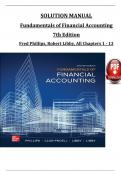Exam (elaborations)
Solution Manual For Fundamentals of Financial Accounting, 7th International Edition by Fred Phillips, Robert Libby, Verified Chapters 1 - 13, Complete Newest Version
- Course
- Institution
Solution Manual For Fundamentals of Financial Accounting, 7th International Edition by Fred Phillips, Robert Libby, Verified Chapters 1 - 13, Complete Newest Version Solution Manual For Fundamentals of Financial Accounting, 7th Edition by Fred Phillips, Robert Libby, Verified Chapters 1 - 13, Compl...
[Show more]



